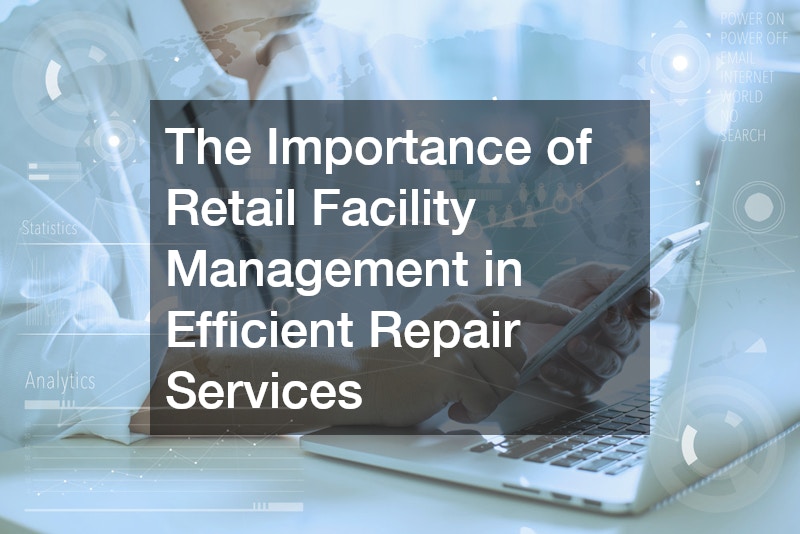Introduction
Retail facility management plays a critical role in maintaining the operational efficiency and longevity of a retail space. Navigating the diverse requirements of equipment maintenance and repair is essential for seamless operations. This article delves into various aspects of facility management, emphasizing preventative measures and effective repair strategies across a range of equipment types.
From ice machine repair in grocery stores to restaurant upholstery repair, every facet of repair impacts both short-term functionality and long-term costs. Understanding how to streamline these processes is at the heart of successful retail management. Let’s explore the intricate dynamics of retail facility management and how it supports business sustainability.
Retail spaces are uniquely challenging environments due to their diverse equipment needs, ranging from complex crane repairs in logistics-heavy stores to delicate Viking oven repair in high-end retailers. Effective management ensures all equipment functions correctly, providing a high-quality customer experience. The key is balancing immediate repair needs with proactive maintenance practices.
How Effective Facility Management Enhances the Longevity of Equipment and Appliances
Effective facility management is pivotal in enhancing the longevity of equipment and appliances within retail spaces. This is achieved by implementing robust maintenance schedules that preemptively address potential issues. Regular maintenance significantly decreases the likelihood of unexpected breakdowns, ensuring continuous service delivery.
Investing in skilled technicians is crucial for retail facility management. These professionals carry out regular check-ups and are adept at spotting the early signs of wear and tear. By intervening early, they can perform necessary repairs, such as crane repairs or auto repair, before issues escalate.
Retail facilities with well-maintained equipment enjoy a competitive edge, as they can reduce downtime and provide a consistent customer experience. Critical systems like refrigeration for perishable goods require regular upkeep. Proactively managing these elements through scheduled maintenance is a cornerstone of effective retail management.
The Role of Facility Oversight in Streamlining Repair Services Across Industries

Facility oversight is a crucial component for streamlining repair services across different industries within the retail sector. It ensures all repair needs, from simple tire repair to complex fire line repair, are addressed promptly and efficiently. An organized system helps prioritize repair tasks, minimizing operational interruptions.
Utilizing a centralized management system allows for the efficient coordination of internal and external repair services. Such systems ensure all repair needs, be they trailer repairs or ice machine repair services, are logged and tackled systematically. This strategic approach enhances both operational efficiency and customer satisfaction.
Moreover, effective facility oversight in retail facility management includes collaborations with outside service providers specializing in various repair domains. Partnering with experts in computer repair services or home repair ensures access to specialized knowledge and quick resolution of issues, facilitating consistent business continuity.
Preventative Maintenance: Reducing the Need for Emergency Fixes in Retail Spaces
Preventative maintenance is a proactive strategy aimed at reducing the frequency of emergency fixes within retail facilities. By scheduling regular maintenance activities, potential problems can be identified and rectified early. This approach is more cost-effective in the long run as it minimizes sudden disruptions and repair costs.
Regular inspections and tune-ups, whether for restaurant upholstery repair or fire line repair, help maintain optimal functionality of equipment. Preventative maintenance is key to preserving operational efficiency, ensuring all elements of the retail environment work smoothly and safely. This foresight protects against potential liabilities.
Incorporating regular maintenance into retail facility management strategies involves a systematic review of equipment and systems. This includes essential tasks like examining Viking ovens or contemplating future crane repair needs. Preventative measures significantly reduce the chance of unexpected breakdowns, bolstering overall operational resilience.
Ensuring Quick Turnaround for Essential Equipment Fixes in Commercial Spaces
Ensuring a quick turnaround for essential equipment repairs in commercial spaces is crucial for maintaining service continuity. This involves having a responsive repair team on standby, capable of addressing urgent repair needs such as ice machine repair and auto repair swiftly and effectively. Rapid response times reduce potential revenue losses.
Effective retail facility management involves setting up contracts with trusted repair specialists. These agreements ensure immediate access to skilled professionals for urgent repairs like trailer repairs and tire repairs, minimizing disruption to operations. Selected repair partners play a vital role in maintaining high standards of service and safety.
A database of trusted service contacts, including those for more complex repairs such as crane repairs, supports seamless repair processes. By integrating such resources into the management strategy, retail facilities ensure continuity and reliability, ultimately enhancing both customer satisfaction and business credibility.
How Proper Management of Retail Spaces Minimizes Downtime During Repairs

Proper management of retail spaces plays an essential role in minimizing downtime during repairs. This can be achieved by using predictive analytics and maintenance schedules to anticipate equipment failures before they occur. Such foresight keeps spaces operational even during necessary repairs, be it ice machine repair or computer repair services.
Implementing a robust communication strategy is crucial for coordinating repairs across various departments within a retail facility. Effective communication ensures that all stakeholders are aware of the repair schedule and any potential impacts. A well-informed team can mitigate disruption and maintain customer satisfaction even in repair scenarios.
Retail facility management entails regular analysis of repair trends, enabling managers to allocate resources effectively. By understanding these patterns, managers can prioritize critical repairs and streamline processes. A consistent focus on reducing downtime supports continuous business operations while maintaining high service standards.
The Critical Role of Timely Repairs in Maintaining Retail Operational Efficiency
Timely repairs play a critical role in maintaining the operational efficiency of retail spaces, directly impacting customer satisfaction and revenue. Rapid intervention prevents minor issues from escalating into major problems that can cause extended downtimes. This is pivotal for complex repairs like crane repairs or fire line repairs.
Retail facility management requires an organized approach to scheduling repairs, allowing for timely interventions. Immediate action on issues like computer repair services or tire repairs can prevent larger disruptions. This organized system ensures shops remain fully functional, providing a seamless retail experience to customers.
The capacity to deliver expedient repairs enhances the reliability patrons have in a business. Internally, timely repairs lead to reduced stress and increased efficiency for employees. For managers, the ability to quickly resolve repair issues allows them to maintain focus on broader operational strategies.
How Regular Maintenance Schedules Reduce the Frequency of Major Breakdowns
Routine maintenance schedules play a significant role in reducing the frequency and severity of major equipment breakdowns. By adhering to a predictive maintenance plan, retail facility management can provide timely interventions, preserving the integrity of crucial systems like viking ovens or ice machines.
Retail facilities that integrate maintenance routines into their operational strategy can prevent sudden and expensive disruptions. Regular checkups address small issues before they grow, whether it’s dealing with restaurant upholstery repair or more essential auto repair needs. This strategy supports long-term financial health and operational predictability.
Creating a sustainable business model hinges on strategic management of repair and maintenance needs. Implementing regular schedules for critical areas reduces repair frequency and the associated financial burden. This proactive strategy delivers continuous service, enhancing the overall customer experience in retail settings.
Managing In-House and External Repair Needs for Optimal Facility Performance

Effectively managing both in-house and external repair needs is key to maintaining optimal retail facility performance. In-house teams can handle routine repairs and daily maintenance tasks, while external experts are employed for specialized needs like crane repairs or complex computer repair services.
Balancing these resources requires a clear strategy that includes allocating tasks based on urgency and complexity. This approach ensures repairs like fire line repair or trailer repairs do not interrupt daily operations. It also fosters a coordinated team effort, maximizing the benefits of both in-house skills and external expertise.
Having a detailed, organized schedule for managing repairs allows retail facilities to minimize disruptions and optimize equipment lifespan. Retail facility management that successfully integrates both internal and external repair strategies enhances operational efficiency, safety, and ultimately customer satisfaction.
Coordinating Complex Repairs Without Disrupting Retail Operations
Coordinating complex repairs without disrupting retail operations requires comprehensive planning and efficient communication strategies. Scheduling repairs during off-peak hours minimizes the impact on daily business activities. This practice is particularly crucial for major tasks such as crane repairs or extensive restaurant upholstery repair.
Effective retail facility management involves having contingency plans in place, ensuring continuity even when significant repairs are necessary. These plans should address potential disruption areas and provide alternative solutions to maintain operational flow. Thorough planning ensures minimal customer inconvenience and sustained business operations.
Prioritizing communication and coordination with repair teams helps streamline complex repairs. By engaging with experienced professionals for specialized tasks like auto repair, facilities can ensure issues are addressed promptly, without unnecessary delay or complication. This approach fosters an environment of reliability and consistency.
Keeping Your Facility Running Smoothly: The Impact of Proactive Repair Strategies
Retail facility management that incorporates proactive repair strategies guarantees smoother business operations and improved cost management. Rather than waiting for malfunctions, facilities benefit from preemptive interventions in essential areas like tire repair and viking oven repair. The anticipation of potential issues saves time and money in the long term.
Using predictive analytics, facilities can determine which pieces of equipment require attention, allowing managers to schedule maintenance proactively. This strategy anticipates repair needs, ensuring optimum machinery performance. Effective proactive management enhances both operational efficiency and customer satisfaction.
Investing in remedy strategies emphasizes preventative measures that prevent equipment faults before they occur. Early detection and resolution of issues lower repair costs and business interruptions. Through tailored preventive measures, retail facilities increase their resilience against potential disruptions.
Integrating Comprehensive Repair Solutions for Retail Spaces and Equipment
Integrating comprehensive repair solutions into retail facility management ensures holistic upkeep of both the facility and equipment. This involves leveraging technology to track maintenance schedules and repair needs, covering everything from computer repair services to ice machine repair. Such integration provides a streamlined process that addresses all potential maintenance concerns.
Retail managers benefit from establishing relationships with reliable repair service providers and regularly reevaluating these partnerships. Engaging external experts for specialized tasks like fire line repair or extensive home repair maximizes repair effectiveness and facilities’ internal resources.
The integration of comprehensive repair solutions into retail facility management enables an uninterrupted operational experience. By encompassing advanced management systems, retail spaces maintain operational efficiency and service quality, fostering customer loyalty and retention.
How Skilled Technicians and Facility Managers Work Together to Minimize Repairs
The collaboration between skilled technicians and facility managers is crucial in minimizing repairs and ensuring smooth operations within retail facilities. Technicians use their expertise to identify equipment issues before they escalate, focusing on preventative measures for trailer and fire line repairs.
Managers play a strategic role, coordinating repair schedules and allocating resources effectively. By understanding the nuances of facility operation, they can provide guidance on prioritizing repairs and managing logistics. This dynamic partnership ensures equipment remains functional and reliable, reducing the frequency of abrupt failures.
Effective communication between technicians and managers enriches the retail facility management framework. An aligned focus on reducing repair needs leads to optimized resource use, sustained performance, and an enhanced customer experience. The harmonious collaboration promotes a proactive approach to maintenance, guaranteeing continuous operations.
The Benefits of Regular Checkups and Monitoring for All Retail Equipment and Systems

Regular checkups and monitoring of all retail equipment and systems are essential practices in retail facility management. These activities help identify potential problems early, allowing for timely repairs like viking oven repair or ice machine repair before more severe issues arise. Regular monitoring secures consistent performance and service delivery.
Conducting frequent equipment inspections ensures defects are detected promptly, enabling minor issues to be corrected before they escalate, a practice that proves cost-effective in the long run. Additionally, routine assessments of systems like fire line repair create safer environments for both customers and employees.
The benefits extend to maintaining a stable operational flow, ultimately enhancing the retail environment. Proactive management through regular monitoring offers a competitive advantage by minimizing unexpected downtimes. It ensures that the equipment and systems are always ready to provide high-level customer service.
Conclusion
In conclusion, retail facility management demands a multifaceted approach that balances immediate repair needs and long-term maintenance strategies. The interplay between proactive measures and timely interventions ensures the extended life of equipment and enhances operational efficiency. By focusing on streamlined processes and professional collaborations, retail spaces can consistently deliver quality service and remain competitively viable.
Effective management encompasses everything from urgent trailer repairs to detailed restaurant upholstery repair, strongly emphasizing reducing disruptions and optimizing resources. Through strategic planning and execution, retail facilities can navigate the complexities of maintaining an engaging and efficient retail environment.
Ultimately, mastering repair and maintenance in retail facility management empowers businesses, promotes regular business rhythms, and provides customers with dependable service experiences, which is the core of sustainable retail operations.




